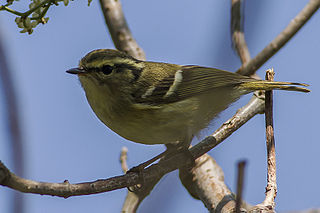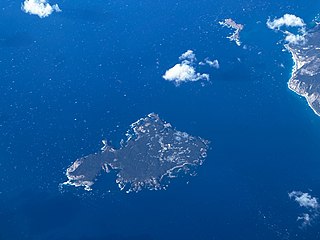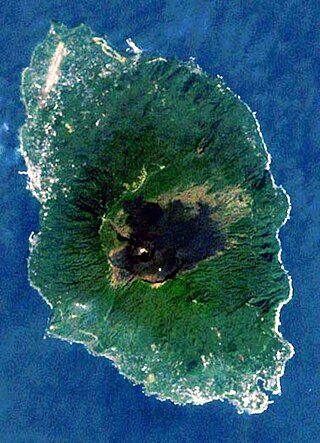
Leaf warblers are small insectivorous passerine birds belonging to the genus Phylloscopus.

The Arctic warbler is a widespread leaf warbler in birch or mixed birch forest near water throughout its breeding range in Fennoscandia and the northern Palearctic. It has established a foothold in North America, breeding in Alaska. This warbler is strongly migratory; the entire population winters in southeast Asia. It therefore has one of the longest migrations of any Old World insectivorous bird.

The lemon-rumped warbler or pale-rumped warbler is a species of Old World warbler in the family Phylloscopidae. It is found from the western Himalayas to central China.

The Izu Islands are a group of volcanic islands stretching south and east from the Izu Peninsula of Honshū, Japan. Administratively, they form two towns and six villages; all part of Tokyo Prefecture. The largest is Izu Ōshima, usually called simply Ōshima.

Kōzu-shima (神津島) is a volcanic Japanese island in the Philippine Sea. The island is administered by Tōkyō and is located approximately 30 kilometres (19 mi) northwest of the Miyake-jima and 14 kilometres (8.7 mi) southwest of the Nii-jima. It is one of the Izu Seven Islands, a group of the seven northern islands of the Izu archipelago. Kōzushima is administratively part of Kōzushima Village, under Ōshima Subprefecture of Tokyo Metropolis. As of 2017, the island's population was 1,952. Kōzushima is within the boundaries of the Fuji-Hakone-Izu National Park.

Miyake-jima is a volcanic island in the Izu archipelago in the Philippine Sea approximately 180 kilometers (110 mi) southeast of Tokyo, Japan. As with the other islands in the Izu Island group, Miyake-jima forms part of the Fuji-Hakone-Izu National Park.

Cuculus saturatus, better well known as the Himalayan cuckoo or Oriental cuckoo, is a brooding parasitic bird that is part of the Cuculidae family. The species breeds from the Himalayas eastward to southern China and Taiwan. It migrates to southeast Asia and the Greater Sunda Islands for the winter.

Shikine-jima (式根島) is a volcanic Japanese island in the Philippine Sea. The island is administered by Tōkyō and located approximately 160 kilometres (99 mi) south of Tōkyō and 36 kilometres (22 mi) south of Shimoda Shizuoka Prefecture. It is one of the Izu Seven Islands, group of the seven northern islands of the Izu archipelago. The island is the smaller inhabited component of the village of Niijima, which also contains the larger, neighboring island of Niijima and the smaller, uninhabited Jinai-tō. It is part of the Ōshima Subprefecture of Tokyo Metropolis. As of 2009, the island's population was 600. Shikinejima is also within the boundaries of the Fuji-Hakone-Izu National Park.

Izu Ōshima is an inhabited volcanic island in the Izu archipelago in the Philippine Sea, off the coast of Honshu, Japan, 22 km (14 mi) east of the Izu Peninsula and 36 km (22 mi) southwest of Bōsō Peninsula. As with the other islands in the Izu Island group, Izu Ōshima forms part of the Fuji-Hakone-Izu National Park. Izu Ōshima, at 91.06 km2 (35.16 sq mi) is the largest and closest of Tokyo's outlying islands, which also include the Ogasawara Islands.

Toshima is a village located in Ōshima Subprefecture, Tokyo Metropolis, Japan. The village comprises the whole of Toshima Island.

Mikura-jima (御蔵島) is an inhabited volcanic Japanese island in the Pacific Ocean. The island is administered by Tōkyō Metropolis and is located approximately 200 kilometres (120 mi) south of Tokyo and 19 kilometres (12 mi) south-southeast of Miyake-shima. It is one of the Izu Seven Islands group of the seven northern islands of the Izu archipelago. Mikurashima is administratively part of Mikurashima Village under Miyake Subprefecture of Tokyo Metropolis. As of 2009, the island's population was 351. Mikura-shima is also within the boundaries of the Fuji-Hakone-Izu National Park.

The western crowned warbler is a leaf warbler which breeds in Central Asia. It winters in the forests of the Western Ghats. It prefers forests with high foliage complexity and tree density.

The Gansu leaf warbler is a small passerine bird known only from China. It belongs to the leaf warbler genus Phylloscopus within the family Phylloscopidae. It was formerly treated as a subspecies of Pallas's warbler but is now regarded as a separate species based on differences in voice and cytochrome-b gene sequences.

The Sakhalin leaf warbler is a species of Old World warbler in the family Phylloscopidae. It is found in Sakhalin, the Kuril Islands and Japan; it winters to the Amami and Okinawa islands.

The eastern crowned warbler is a species of Old World warbler in the family Phylloscopidae. It inhabits boreal and temperate forests in the east Palearctic.

Aogashima (青ヶ島) is a volcanic island to the south of Japan in northernmost Micronesia. It is the southernmost and most isolated inhabited island of the Izu Islands. The islands border the northeast Philippine Sea and lie north of the Ogasawara Islands. The island lies approximately 358 kilometres (222 mi) south of mainland Tokyo and 64 kilometres (40 mi) south of Hachijō-jima.

Owston's tit is a small passerine bird in the tit family Paridae that is endemic to the southern Izu Islands south of Japan, occurring only on the islands of Miyakejima, Mikurajima and Hachijojima.

Emydocephalus ijimae, commonly known as Ijima's sea snake and turtlehead sea snake, is a species of snake in the family Elapidae. The species occurs in East Asia, in the shallow coastal waters of the north-western Pacific Ocean. E. ijimae feeds exclusively on the eggs of coral reef fishes, which makes it an important predator for maintaining a healthy coral reef ecosystem.
The Bonin greenfinch, also known as the Ogasawara greenfinch, is a small passerine bird in the finch family Fringillidae that is endemic to the Ogasawara Islands of Japan, where it is found on the Bonin Islands and Volcano Islands. It was formerly considered a subspecies of the grey-capped greenfinch and some authorities consider it as such, but a 2020 analysis found it likely to represent a distinct species that diverged from C. sinica about 1.06 million years ago, and the International Ornithological Congress now recognizes it as such, making it the eleventh endemic species in Japan. There are fewer than 400 individuals in the population and it is considered critically endangered by the Japanese government, necessitating protection. According to the Yamashina Institute for Ornithology, as of December 2021, the Ogaswara greenfinch is Japan's most endangered bird.

Isao Ijima was a Japanese zoologist known for his studies of sponges (Porifera) — including his circumscription of the genus Staurocalyptus — leeches (Hirudinea), flatworms (Turbellaria), birds, and fish. Professor of Zoology at Tokyo Imperial University, he is considered the founder of parasitology in Japan and was the first President of the Ornithological Society of Japan. Taxa named in his honour include Ijima's sea snake and Ijima's leaf warbler.






















